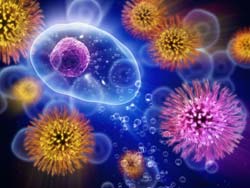Biochemical cell signals quantified for first time

Can you hear me now? When you feel symptoms of a nasty bug, you phone the doctor. Cells in your body are also receiving “calls,” through a biochemical signaling pathway that turns out to have surprisingly low data capacity. Image: iStockphoto.com<br>
Now, for the first time, scientists have quantified the data capacity of a biochemical signaling pathway and found a surprise – it’s way lower than even an old-fashioned, dial-up modem.
“This key biochemical pathway is involved in complex functions but can transmit less than one bit – the smallest unit of information in computing,” says Ilya Nemenman, an associate professor of physics and biology at Emory University. “It’s a simple result, but it changes our view of how cells access chemical data.”
The journal Science is publishing the discovery by Nemenman and colleagues from Johns Hopkins University, including Andre Levchenko, Raymond Cheong, Alex Rhee and Chiaochun Joanne Wang.
During the 1980s, cell biologists began identifying key signaling pathways such as nuclear factor kappa B (NF-kB), known to control the expression of genes in response to everything from invading pathogens to cancer. But the amount of information carried by chemical messengers along these pathways has remained a mystery.
“Without quantifying the signal, using math and computer analysis to attach a number to how much information is getting transmitted, you have a drastically incomplete picture of what’s going on,” says Nemenman, a theoretical biophysicist.
He and Levchenko, a biomedical engineer, began discussing the problem back in 2007 after they met at a conference.
Levchenko developed microfluidic and measurement techniques to conduct experiments on bio-chemical signaling of the NF-kB pathway, and measure the transmissions occurring on the pathway in many thousands of cells at one time. Nemenman formulated the theoretical framework to analyze and quantify the results of the experiments.
“It was a shock to learn that the amount of information getting sent through this pathway is less than one bit, or binary digit,” Nemenman says. “That’s only enough information to make one binary decision, a simple yes or no.”
And yet NF-kB is regulating all kinds of complex decisions made by cells, in response to stimuli ranging from stress, free radicals, bacterial and viral pathogens and more. “Our result showed that it would be impossible for cells to make these decisions based just on that pathway because they are not getting enough information,” Nemenman says. “It would be like trying to send a movie that requires one megabit per second through an old-style modem that only transmits 28 kilobits per second.”
They analyzed the signals of several other biochemical pathways besides NF-kB and got a similar result, suggesting that a data capacity of less than one bit could be common. So if cells are not getting all the information through signaling pathways, where is it coming from?
“We’re proposing that cells somehow talk with each other outside of these known pathways,” Nemenman says. “A single cell doesn’t have enough information to consider all the variables and decide whether to repair some tissue. But when groups of cells talk to each other, and each one adds just a bit of knowledge, they can make a collective decision about what actions to take.”
He compares it to a bunch of people at a cocktail party, with cell phones that have weak signals pressed to their ears. Each person is receiving simple messages via their phones that provide a tiny piece to a puzzle that needs to be solved. When the people chatter together and share their individual messages, they are able to collectively arrive at a reliable solution to the puzzle.
A similar phenomenon, called population coding, had been identified for the electrical activity of neural networks, but Nemenman and his colleagues are now applying the idea to bio-chemical pathways.
They hope to build on this research by zeroing in on the role of cell signaling in specific diseases.
In particular, Nemenman wants to analyze and compare the signaling capacities of a cancerous cell versus a normal cell.
“Cancerous cells divide when they shouldn’t, which means they are making bad decisions,” he says. “I would like to quantify that decision-making process and determine if cancer cells have reduced information transduction capacities, or if they have the same capacities as healthy cells and are simply making wrong decisions.”
Nemenman uses a malfunctioning computer as an example. “If you push the ‘a’ key on your computer and a ‘d’ always shows up, that means the computer is misprogrammed but the information from your keystroke gets through just fine,” he says. “But if you keep pressing the letter ‘a’ and different, random letters show up, that indicates a problem with the way the information is being transmitted.”
Media Contact
All latest news from the category: Life Sciences and Chemistry
Articles and reports from the Life Sciences and chemistry area deal with applied and basic research into modern biology, chemistry and human medicine.
Valuable information can be found on a range of life sciences fields including bacteriology, biochemistry, bionics, bioinformatics, biophysics, biotechnology, genetics, geobotany, human biology, marine biology, microbiology, molecular biology, cellular biology, zoology, bioinorganic chemistry, microchemistry and environmental chemistry.
Newest articles

Bringing bio-inspired robots to life
Nebraska researcher Eric Markvicka gets NSF CAREER Award to pursue manufacture of novel materials for soft robotics and stretchable electronics. Engineers are increasingly eager to develop robots that mimic the…

Bella moths use poison to attract mates
Scientists are closer to finding out how. Pyrrolizidine alkaloids are as bitter and toxic as they are hard to pronounce. They’re produced by several different types of plants and are…

AI tool creates ‘synthetic’ images of cells
…for enhanced microscopy analysis. Observing individual cells through microscopes can reveal a range of important cell biological phenomena that frequently play a role in human diseases, but the process of…





















